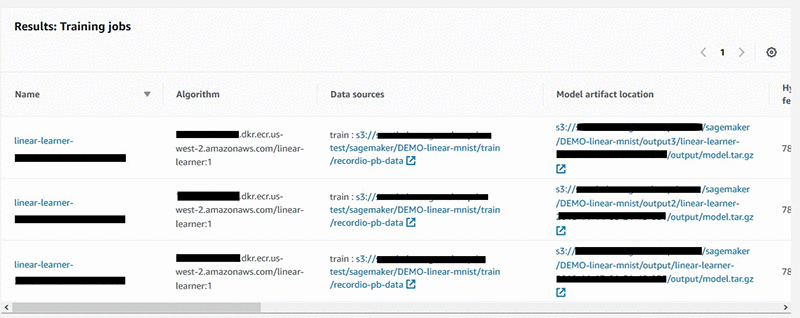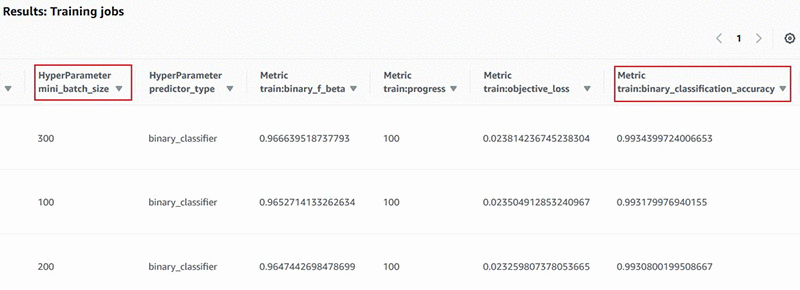Artificial Intelligence
Using model attributes to track your training runs on Amazon SageMaker
With a few clicks in the Amazon SageMaker console or a few one-line API calls, you can now quickly search, filter, and sort your machine learning (ML) experiments using key model attributes, such as hyperparameter values and accuracy metrics, to help you more quickly identify the best models for your use case and get to production faster. The new Amazon SageMaker model tracking capability is available through both the console and AWS SDKs in all available AWS Regions, at no additional charge.
Developing an ML model requires experimenting with different combinations of data, algorithm, and parameters—all the while evaluating the impact of small, incremental changes on performance and accuracy. This iterative fine-tuning exercise often leads to data explosion, with hundreds or sometimes thousands of experiments spread across many versions of a model.
Managing these experiments can significantly slow down the discovery of a solution. It also makes it tedious to trace back the lineage of a given model version so that the exact ingredients that went into brewing it can be identified. This adds unnecessary extra work to auditing and compliance verifications. The result is that new models don’t move to production fast enough to provide better solutions to problems.
With Amazon SageMaker’s new model tracking capabilities, you can now find the best models for your use case by searching on key model attributes—such as the algorithm used, hyperparameter values, and any custom tags. Using custom tags lets you find the models trained for a specific project or created by a specific data science team, helping you meaningfully categorize and catalog your work.
You can also rank and compare your model training attempts based on their performance metrics, such as training loss and validation accuracy. Do this right in the Amazon SageMaker console to more easily pick the best models for your use case. Finally, you can use the new model tracking capability to trace the lineage of a model all the way back to the dataset used in training and validating the model.
Now, I dive into the step-by-step experience of using this new capability.
Find and evaluate model training experiments
In this example, you train a simple binary classification model on the MNIST dataset using the Amazon SageMaker Linear Learner algorithm. The model predicts whether a given image is of the digit 0 or otherwise. You tune the hyperparameters of the Linear Learner algorithm, such as mini_batch_size, while evaluating the binary_classification_accuracy metric that measures the accuracy of predictions made by the model. You can find the code for this example in the sample notebook in the amazon-sagemaker-examples GitHub repo.
Step 1: Set up the experiment tracking by choosing a unique label for tagging all of the model training runs
You can also add the tag using the Amazon SageMaker Python SDK API while you are creating a training job using the Amazon SageMaker estimator.

You can also add the tag using the Amazon SageMaker Python SDK API while you are creating a training job using SageMaker estimator.
Step 2: Perform multiple model training runs with new hyperparameter settings
For demonstration purposes, try three different batch_sizes values of 100, 200, and 300. Here is some example code:
You are consistently tagging all three model training runs with the same unique label so you can track them under the same project. In the next step, I show how you can find and group all model training runs labeled with the “Project” tag.
Step 3: Find the relevant training runs for further evaluation
You can find the training runs on the Amazon SageMaker console.

You can search for the tag used in Steps 1 and 2.

This lists all labeled training runs in a table.

You can also use the AWS SDK API for Amazon SageMaker.
While I have demonstrated searching by tags, you can search using any metadata for model training runs. This includes the learning algorithm used, training dataset URIs, and ranges of numerical values for hyperparameters and model training metrics.
Step 4: Sort on the objective performance metric of your choice to get the best model
The model training runs identified in Step 3 are presented to you in a table, with all of the hyperparameters and training metrics presented in sortable columns. Choose the column header to rank the training runs for the objective performance metric of your choice, in this case, binary_classification_accuracy.

You can also print the table inline in your Amazon SageMaker Jupyter notebooks. Here is some example code:
As you can see in Step 3, you had already given the sort criteria in the search() API call for returning the results sorted on the metric of interest as follows:
The previous example code parses the JSON response and presents the results in a leaderboard format, which looks like the following:

Now that you have identified the best model—with batch_size = 300, and classification accuracy of 0.99344—you can now deploy this model to a live endpoint. The sample notebook has step-by-step instructions for deploying an Amazon SageMaker endpoint.
Tracing a model’s lineage
Now I show an example of picking a prediction endpoint and quickly tracing back to the model training run used in creating the model in the first place.
Using single-click on the Amazon SageMaker console
In the left navigation pane of the Amazon SageMaker console, choose Endpoints, and select the relevant endpoint from the list of all your deployed endpoints. Scroll to Endpoint Configuration Settings, which lists all the model versions deployed at the endpoint. You see an additional hyperlink to the model training job that created that model in the first place.

Using the AWS SDK for Amazon SageMaker
You can also use few simple one-line API calls to quickly trace the lineage of a model.
Get started with more examples and developer support
Now that you have seen examples of how to efficiently manage the ML experimentation process and trace a model’s lineage, you can try out a sample notebook in the amazon-sagemaker-examples GitHub repo. For more examples, see our developer guide, or post your questions on the Amazon SageMaker forum. Happy experimenting!
About the Author
 Sumit Thakur is a Senior Product Manager for AWS Machine Learning Platforms where he loves working on products that make it easy for customers to get started with machine learning on cloud. In his spare time, he likes connecting with nature and watching sci-fi TV series.
Sumit Thakur is a Senior Product Manager for AWS Machine Learning Platforms where he loves working on products that make it easy for customers to get started with machine learning on cloud. In his spare time, he likes connecting with nature and watching sci-fi TV series.
This post was originally published November 28, 2018. Last updated August 2, 2019.